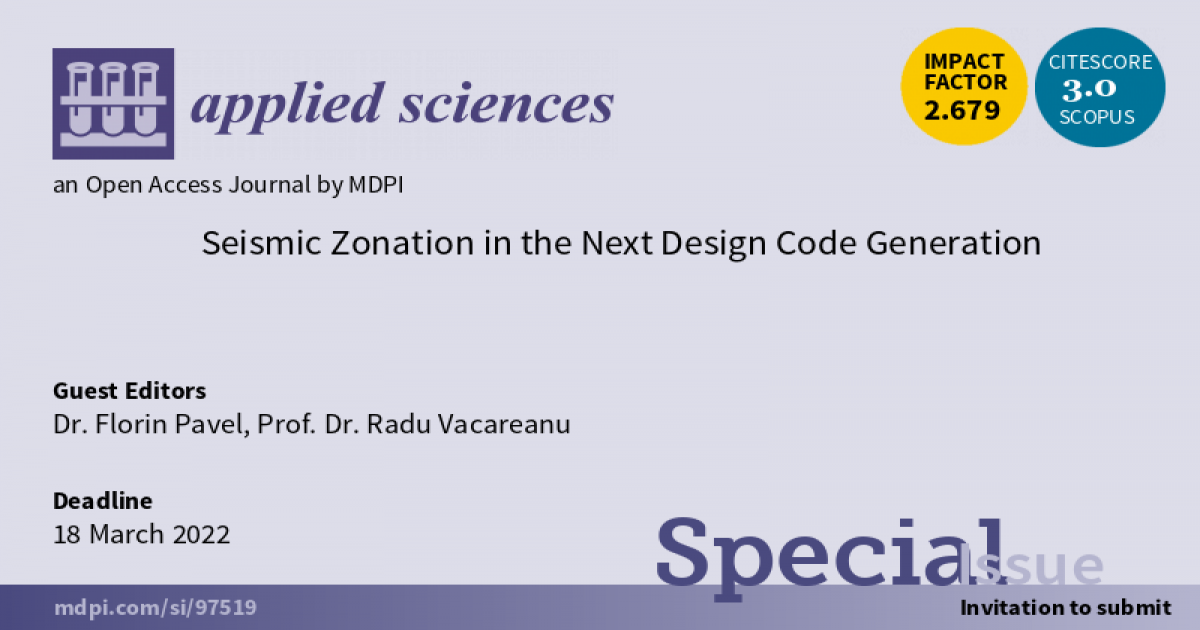Seismic Zonation in the Next Design Code Generation
A special issue of Applied Sciences (ISSN 2076-3417). This special issue belongs to the section "Environmental Sciences".
Deadline for manuscript submissions: closed (18 March 2022) | Viewed by 8688

Special Issue Editors
Interests: risk and fragility analysis; earthquake; seismology; seismics; earthquake seismology; earthquake engineering; civil engineering; seismotectonics; engineering seismology; earthquake prediction; tectonics; applied geophysics; active tectonics
Special Issues, Collections and Topics in MDPI journals
Interests: earthquake; hazard; fragility; vulnerability; exposure; risk
Special Issues, Collections and Topics in MDPI journals
Special Issue Information
Dear Colleagues,
We are inviting submissions to this Special Issue dedicated to seismic zonation in the next-generation design codes.
In the light of the next-generation Eurocode 8, the seismic zonation maps at national level will be updated. The impact of such changes on new buildings and structures has to be evaluated from the point of view of structural safety. Among the most important changes in next-generation design codes is the definition of site conditions, an aspect which needs further research. Another critical aspect is related to the impact of the uniform risk versus uniform hazard approach. Moreover, other aspects related to the design response spectra, vertical ground motion, or assessment of seismic hazard uncertainty are also important aspects which have to be analyzed.
The aim of this Special Issue is to collect and disseminate the latest research in these fields from world-leading researchers. Contributions related to seismic hazard assessment, evaluation of site conditions, uniform hazard, and risk data from recent earthquakes in Europe are most welcome.
Dr. Florin Pavel
Prof. Dr. Radu Vacareanu
Guest Editors
Manuscript Submission Information
Manuscripts should be submitted online at www.mdpi.com by registering and logging in to this website. Once you are registered, click here to go to the submission form. Manuscripts can be submitted until the deadline. All submissions that pass pre-check are peer-reviewed. Accepted papers will be published continuously in the journal (as soon as accepted) and will be listed together on the special issue website. Research articles, review articles as well as short communications are invited. For planned papers, a title and short abstract (about 100 words) can be sent to the Editorial Office for announcement on this website.
Submitted manuscripts should not have been published previously, nor be under consideration for publication elsewhere (except conference proceedings papers). All manuscripts are thoroughly refereed through a single-blind peer-review process. A guide for authors and other relevant information for submission of manuscripts is available on the Instructions for Authors page. Applied Sciences is an international peer-reviewed open access semimonthly journal published by MDPI.
Please visit the Instructions for Authors page before submitting a manuscript. The Article Processing Charge (APC) for publication in this open access journal is 2400 CHF (Swiss Francs). Submitted papers should be well formatted and use good English. Authors may use MDPI's English editing service prior to publication or during author revisions.
Keywords
- seismic hazard
- site conditions
- ground motion
- design response spectra
- uncertainty
- seismic sources
- mean return period
- limit states






